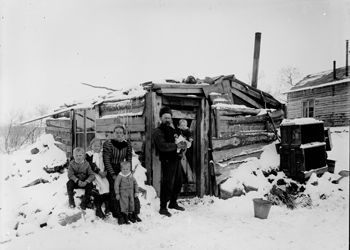I’m learning a lot about Kiruna’s history at the moment. Pouring over library books, I’m beginning to piece together a clear picture of the town, and I wish it hadn’t been so difficult. There’s nowhere in Kiruna you can go to learn about the history of the town – no museum. It’s as if the town is somehow ashamed of its history. I’m sure no-one would say they were though, that’s the funny thing.
All the history you can stumble over, if you’re lucky and it happens to be open, is what’s at ‘Hjalmar Lundbohms gård’, the building where the first director of the mine lived. There, and in the new ‘Gruvstadsparken’ (the newly created ‘buffer zone’ between the town and the mine) there are some photos of Kiruna’s first inhabitants, the first baby born, christened ‘Kiruna’, a few more photos of Lundbohm and his associates in those early mining days, and some photos of the workers building the railway to Narvik. That’s it. The guide at the Lundbohm’s old home said, ‘poor little Kiruna, she had such a terrible life…’
(Above: ‘Poor little Kiruna’…..)
The history of the town is a lot more interesting than that though. In 1900 there were already three distinct areas marked out, one for the mining company and its workers, one for the railway company and its workers, and one for the rest of the town. In just a couple of years Kiruna saw an explosion of incomers – both people visiting (the state had an interest in the mine so ‘the great and the good’ made the journey up here in open rail trucks to see what was going on). There was a gold rush feeling for a while, a scrabbling for land and resources. A worker here could earn four to six times as much as they could further south, and the new town offered huge opportunities for new businesses. A town plan was drawn up in 1900, and we can see that the street we live in now – not built on until around 1920 – was already laid out in that plan.
If you’ve been paying attention to my blog entries (and why would you?) then you’ll remember we glory in the street name ‘Tvärgatan’, which means ‘contrary street’ – and we feel a bit contrary, don’t mind being different, so it suits us rather well. The angle of the street is different to the streets around it (as shown even in the 1900 plan) so we assumed that was the reason for the name. A few months ago we complained to the council that there was no street sign.
Well, glory be! After waiting four months, our street now has a sign with its name. And the name, we now find out, means…. ‘one of the many streets going in another direction to the main street’. It turns out that from 1900, all the streets off the main drag were called ‘Tvärgatan’. It was what they were called before they got a real name. So we’ve been fighting to get a sign put up which really says, ‘the street which never really got a name’. Great.
I’ve also been reading a ‘who’s who’ guide to street names here. Significant characters in Kiruna’s past have had streets named after them. It was 1988 when people noticed that not one street was named after a woman, and the first (and only) woman to be so honoured was ‘Syster Mia’, who was a thoroughly resourceful district nurse who was by all accounts unstoppable, obeyed without question by the staff who worked with her and the patients who crossed her path.
There were plenty of women involved with the founding of the town, who have disappeared in the history books. One such woman must be Anna Mesch, wife of the famous photographer Borg Mesch, who was here from Kiruna’s first days, photographed most of its inhabitants and events, and was involved in setting up almost every local organisation. His wife was dragged up here to the frozen north, where he fancied a bit of adventure and mountain climbing. She worked in his photography studio and raised five children while he was out gallivanting around the ‘fjäll’ or enjoying trips to Stockholm for dinners out with his mates.
So, let’s rename our street, the street that doesn’t really have a name, ‘Anna Mesch street’.

